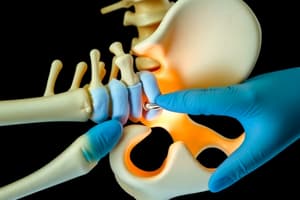Podcast
Questions and Answers
What is the primary function of a Neutralization Plate?
What is the primary function of a Neutralization Plate?
- To compress the fracture
- To maintain the length and rotation of the bone
- To protect the screws from shear, bending, and torsional forces (correct)
- To resist shear forces during axial loading
What type of screw is used when the bone is weak and requires additional support?
What type of screw is used when the bone is weak and requires additional support?
- Locking screw
- Cancellous screw (correct)
- Cortical screw
- Cannulated screw
What is the primary goal of a Bridge Plate?
What is the primary goal of a Bridge Plate?
- To resist shear forces during axial loading
- To bypass comminution and maintain axial alignment (correct)
- To maintain the length and rotation of the bone
- To compress the fracture
What is the advantage of using titanium screws and plates?
What is the advantage of using titanium screws and plates?
What is the purpose of a sleeve in plate and screw fixation?
What is the purpose of a sleeve in plate and screw fixation?
What is the primary function of osteoclasts during bone repair?
What is the primary function of osteoclasts during bone repair?
Which type of fixation is characterized by a flexible construct that allows for some micromotion at the fracture site?
Which type of fixation is characterized by a flexible construct that allows for some micromotion at the fracture site?
Which of the following is NOT a type of fixation construct?
Which of the following is NOT a type of fixation construct?
What is the primary goal of maintaining the angle between the head and neck stable during the treatment of intertrochanteric fractures?
What is the primary goal of maintaining the angle between the head and neck stable during the treatment of intertrochanteric fractures?
What is the final stage of bone repair in the Haversian remodeling process?
What is the final stage of bone repair in the Haversian remodeling process?
Study Notes
Bone Repair
- Types of bone repair: primary and secondary
- Steps of bone repair: inflammation, soft callus, hard callus, and remodeling
Biology of Bone Healing
- Absolute stability: 20% bone healing, rigid fixation, e.g., lag screw/plate, compression plate
- Relative stability: 10% bone healing, flexible fixation, e.g., IM nailing, ex fix, bridge plating, cast
Fixation Techniques
- Fixation constructs: operative, external fixation, plates, intramedullary nails
- Fixation stability:
- Relative stability: IM nailing, external fixation, bridge plating, cast
- Absolute stability: lag screw/plate, compression plate
Screw Fixation
- Types of screws:
- Cortical screws: smaller pitch, smaller thread height
- Cancellous screws: larger pitch, larger thread height
- Cannulated screws
- Locking screws
- Anatomy of a screw:
- Head
- Thread height
- Inner (core) diameter
- Outer (thread) diameter
- Pitch
Plate Fixation
- Types of plate fixation:
- Compression plates: compress plate to bone, maintain fracture compression
- Neutralization plates: protect screws from shear, bending, and torsional forces
- Buttress/Anti-Glide plates: resist shear forces during axial loading
- Bridge plates: maintain length, rotation, and axial alignment, avoid soft tissue disruption
Operative Rituals
- Important notes:
- Verify patient's identity in the operative room
- Check patient's sensitivity to drugs
- Use titanium implants for MRI compatibility
- Use sleeve to maintain soft tissues
Studying That Suits You
Use AI to generate personalized quizzes and flashcards to suit your learning preferences.
Related Documents
Description
This quiz covers the biology of bone healing, types of bone repair, and various fixation techniques. Topics include primary and secondary bone repair, steps of bone healing, and fixation constructs.



